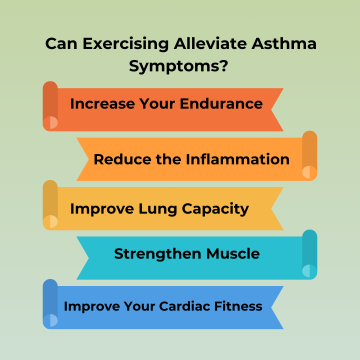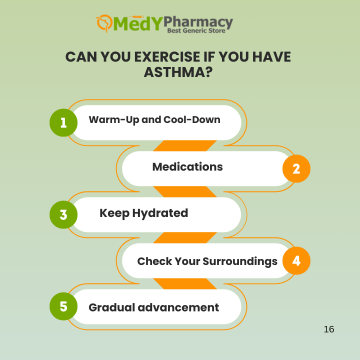Introduction:
Living with this can be difficult, especially when it comes to selecting the appropriate sort of exercise. While physical activity is essential for good health, people with asthma may struggle to strike a balance between being active and controlling their respiratory disease.
In this post, we’ll look at what type of exercise is best for those with asthma. Furthermore, determines the finest solutions for those with asthma.
Exercise also boosts blood flow to your lungs, which in turn promotes blood flow to the heart, which pumps oxygen throughout your body. People who exercise, for example, have a greater ability to extract oxygen from their lungs and into their bloodstream, which then nourishes the muscles that keep us going.
Most people take breathing for granted, except for individuals who have severe asthma. This narrows your lungs’ airways, making it difficult to breathe.
Inhaled corticosteroids and beta-agonists are medications that open up your airways, allowing you to breathe better. However, for some persons with severe asthma, these medicines may not be sufficient to control symptoms.
If you’re seeking something to help with your drug therapy, consider breathing exercises.
Can Persons With Asthma Exercise?
With physical activity, around one in every ten people experiences asthma-related symptoms. Symptoms may appear during or immediately after strenuous exertion. Many people are unaware that they have asthma and therefore avoid activity.
- Improved lung function can increase stamina.
- Strengthen muscles – beneficial to all regions of the body, promotes blood flow to the lungs and heart.
- Weight loss lessens the chance of asthma flare-ups.
- Improved immune system performance minimizes the chance of acquiring respiratory infections.
- Enhanced well-being and quality of life
- Stress reduction
Understanding Asthma through Exercise
Before getting into the best types of exercise for people with asthma, it’s important to understand the link between physical activity and asthma. This is a chronic respiratory illness characterized by airway inflammation and constriction, which results in symptoms such as trouble breathing, shortness of breath, and chest tightness.
Exercise-induced bronchoconstriction (EIB) is a significant worry for asthmatic patients, where physical activity causes asthma symptoms.
Regular physical activity is good for your health, and many types of exercise can be modified to suit those with asthma.
However, exercise or physical activity might occasionally induce an asthma attack. This is called exercise-induced bronchoconstriction (EIB). Previously, it was called exercise-induced asthma.
- Up to fifty percent of competitive athletes
- 18-26% of schoolchildren.
Frequent exercise will enhance your general health and well-being.
You should be able to exercise as frequently as you choose. If you frequently encounter asthma symptoms while exercising, speak with your doctor or a respiratory expert.
People with asthma should be able to participate in practically any sport or physical activity. Scuba diving is the only sport that is not universally endorsed.
Most asthmatics can exercise to their full potential provided they have good asthma management.
What Is The Definition Of Exercise-Induced Asthma?
This is sometimes known as exercise-induced asthma (EIA). Airway muscle spasms in EIB limit airflow. These symptoms usually develop 5-10 minutes after the workout begins or ends.
If you believe you have EIB, consult a doctor. Your doctor will obtain your medical history and have you undergo a breathing test. These breathing tests are done after exercising and while resting.
Some asthmatics only have symptoms while exercising or performing physically demanding chores. This is referred to as exercise-induced asthma or exercise-induced bronchospasm. But you don’t have to let asthma prevent you from being active. Asthma is common among Olympians and professional athletes. You can engage in any sport or activity as long as your symptoms are under control.
If you get asthma symptoms during or immediately after exercise, consult your doctor. Are you simply unfit? Is the asthma exercise-induced or poorly controlled? You’ll need to consult with your doctor to determine which form of asthma you have. You may benefit from other treatment options, such as adding a daily controller medication to your treatment regimen.
Exercising Safely With Asthma
Asthmatics may be particularly vulnerable to severe temperatures, dry air, allergens, and pollution. At repose, breathing through the nose moistens, warms, and filters air before it enters the lungs. Most individuals breathe through their mouth during activity, which can exacerbate asthma symptoms, thus those with asthma may feel better breathing in through the nose and out through the mouth. People with asthma should avoid overexertion because it can aggravate their symptoms. Consistent activity is often tolerated better, although asthmatics should discontinue exercise if they experience considerable symptoms.
Is It Safe to Exercise If You Have Asthma?
One of the goals of this treatment is to help you live a normal and healthy lifestyle that includes exercise and other physical activity. Taking your medications as prescribed, avoiding triggers, and monitoring your symptoms and lung function will help you reach this objective.
If asthma symptoms keep you from completely participating in activities, consult your asthma doctor. A modest adjustment to your asthma action plan may be all that is required to provide asthma relief during exercise or other activities.
Can Exercise Help With My Asthma?
- Improve the function of your lungs
- Boost your immune system to acquire fewer colds.
- Help you lose weight, which can reduce your chances of having an asthma attack.
- Create “feel-good” hormones in your body to combat depression and stress.
Best and Worst Exercises for Asthma
Team sports requiring short bursts of intensity, such as volleyball, gymnastics, baseball, and wrestling, are beneficial, as are solo or group leisure activities like walking, biking, and hiking. Swimming is also an excellent choice because it allows you to inhale a lot of warm, wet air. It’s also an excellent approach to improving upper-body strength.
Long-duration activities, such as soccer, distance running, basketball, and field hockey, may be difficult. Ice hockey, cross-country skiing, and ice skating are all cold-weather activities that can be difficult. However, many persons with this can fully participate in such activities.
Can Exercising Help With Asthma?
In general, exercise has numerous health benefits, including increasing heart health, strengthening mental health, and lowering the risk of various diseases.
- Enhanced lung function, which increases overall stamina and decreases the time it takes for a person to feel out of breath.
- Weight loss can lower the risk of asthma episodes.
- Enhanced immune system performance, which minimizes the chance of upper respiratory infections that can cause asthma symptoms.
- Improved mood and stress reduction can reduce asthma symptoms.
- Increased energy throughout the day
- Blood sugar levels are stabilized.
- Protecting the brain from age-related diseases
- Strengthened bones and muscles
- Reduced risk of specific cancers
- Enhanced sexual experiences
- Improved sleep quality
- Lower risk of heart disease
- Assisting a person to quit smoking.
Low-Impact Cardiovascular Exercises
Low-impact cardiovascular workouts are frequently suggested for people with asthma because they increase cardiovascular health while putting less burden on the respiratory system. Swimming comes out as a fantastic choice.
Indoor pools’ warm and humid climate can help minimize the risk of EIB, while the buoyancy of water supports the body and makes breathing easier. Swimming can also increase lung function and overall respiratory endurance due to its rhythmic nature.
Walking is another low-impact activity option. This is a basic but effective workout that can be adapted to each individual’s fitness level. A daily walking habit not only improves cardiovascular health but also aids in weight control, which can affect asthma symptoms.
Walking in nature or places with clean air can have additional respiratory benefits. Medical reduces inflammation and suffering associated with a variety of inflammatory disorders.
Tips for Healthy Lungs
- In general, people with asthma can engage in all forms of exercise. You might need to take medication before you work out.
- Warm-ups are necessary before beginning any exercise.
- When exercising outside in chilly weather, wear a scarf to cover your nose and mouth.
- Exercise or intense activity outside should be limited when the air quality is bad and avoided when the air quality is red, purple, or maroon.
- Remember to provide a cooling-off period.
If you get pain or a tight feeling in your chest pain, cough, or become short of breath during exercise, stop immediately. Take your inhaler for rapid relief. Sit down and attempt to relax. Relaxation can be achieved by belly breathing exercises. Kids should notify an adult as soon as symptoms appear, take their medication, and sit down and attempt to relax.
Knowing your symptoms can help you take action before your breathing worsens.
Can exercising alleviate asthma symptoms?
Certain types of exercise can alleviate or prevent asthma symptoms. They operate by strengthening your lungs without increasing inflammation.

- Increase Your Endurance
Working out over time can help your airways develop a tolerance for activity. This allows your lungs to undertake actions that would normally make you winded, such as walking up stairs.
- Reduce the Inflammation
Although asthma causes inflammation in the airways, regular exercise can help reduce inflammation. It works by lowering inflammatory proteins, and improving how your airways respond to exercise.
- Improve Lung Capacity
The more you exercise, the more your lungs adjust to taking oxygen. This reduces the amount of effort your body has to expend to breathe daily.
- Strengthen Muscle
When your muscles are strong, your body performs more efficiently during daily activities.
- Improve Your Cardiac Fitness
Exercise improves the heart’s overall condition, increasing blood flow and oxygen delivery.
Yoga and Breathing Exercises
Yoga, with its emphasis on controlled breathing and gentle movements, is ideal for asthmatics.
- Pranayama, a series of breathing techniques in yoga, can enhance lung function and help people gain more control over their breathing.
- When performed thoughtfully, yoga postures can increase flexibility and strength without exerting too much effort.
- Individuals with this may benefit from breathing techniques such as pursed-lip breathing and diaphragmatic breathing.
- These strategies concentrate on slowing down the breath and improving airflow, lowering the likelihood of initiating asthma symptoms during exercise.
- Regular practice of breathing exercises can help lower the intensity of these symptoms and make physical activity more manageable.
- Breathing exercises can also improve general physical and mental wellness.
What Should I Do to Manage My Asthma When I Exercise?
They will advise you on which activities are best suited to your needs. They will devise an action plan that will instruct you on what to do before exercise and what to do if you experience symptoms while exercising.
- Always use your pre-exercise medication, as indicated by your asthma action plan, before beginning activity.
- Warm-up activities should be done first, followed by a decent cool-down session.
- If it’s cold outside, exercise indoors or put on a mask or scarf to cover your nose and mouth.
- If you have allergic asthma, avoid exercising outdoors while pollen counts or air pollution levels are high.
- When you have a viral infection, such as a cold, limit your workout time.
- Exercise at an appropriate level for you.
Physical and mental health benefits from regular exercise. Remember, this is not an excuse to avoid exercising. With a good diagnosis and the most efficient therapy, you should be able to get the benefits of an exercise routine while remaining asthma-free.
What Should I Do If I Experience an Asthma Attack While Exercising?
Your doctor will most likely discuss exercise-induced bronchoconstriction with you. It can happen to anyone, with or without asthma. It occurs when your airways contract and you have this symptom while exercising.
- Coughing
- Wheezing
- Tightness in the chest
- Shortness of breath
If this occurs, stop and follow the recommendations in your asthma action plan. Keep your emergency inhaler handy and use it as soon as you notice symptoms. If your symptoms don’t improve, get immediate medical attention.
What Exercises Are Helpful For Asthmatics?
In general, the best asthma workouts include short bursts of activity. Gentle, low-intensity activities are also beneficial. These workouts do not overwork your lungs, so they are less likely to trigger symptoms.
Everyone is unique, however. Remember to see your doctor and pay attention to your body.
- Swimming
Swimming is one of the most recommended forms of exercise for asthmatics. It is less likely than other activities to trigger asthma-related symptoms because:
Conditions: moist, warm air, low pollen exposure, and chest fluid pressure.
Despite its advantages, chlorinated pools might produce problems in certain people. If you’re new to swimming pools, proceed with caution.
- Walking
Walking is another excellent low-intensity exercise option. This type of workout is mild on the body and makes it easier to breathe.
Walking outside only when it’s warm is the most comfortable experience. Dry, chilly air can exacerbate your symptoms.
- Hiking
Another alternative is to go on a gentle hike. Choose a trail that is reasonably flat or has a gradual ascent.
If you have allergies, check the pollen level in your area before trekking. Only increase if pollen counts are low.
- Biking For Recreation
If you have EIB, try biking at a relaxed speed. This is another gentle pastime that doesn’t require constant effort.
Indoor cycling can also be done using a stationary bike.
- Short Track And Field
If you want to run, choose short-distance exercises like sprinting.
Long-distance running on a track or outside may not be suggested for those with severe asthma due to the continual effort required.
Sports That Involve Quick Bursts of Action
These exercises need intermittent breaks, which are easier on the lungs.
- Baseball
- Gymnastics
- Volleyball
- Golf
- Football
Strength and Resistance Exercises
When done correctly, strength training can be a helpful addition to an asthmatic exercise routine. Resistance workouts, whether with body weight or modest weights, can assist enhance muscle strength and endurance. Strength training can improve respiratory muscles, making breathing more efficient.
Begin with modest resistance and gradually increase intensity to allow the body to adjust to the demands of strength training. Furthermore, getting enough rest between sessions and remaining hydrated are important factors for avoiding overexertion and reducing the likelihood of asthma symptoms.
Proper form is also essential for minimizing the danger of damage. Warming up before and stretching after exercise can also assist in minimizing the risk of asthma attacks. Medrol 16 Mg can help you get relief from more severe symptoms by providing effective anti-inflammatory support.
Tailoring Exercises for Individuals
While some people with this can handle specific types of activity, it is important to remember that everyone’s asthma experience is unique. As a result, the most effective type of exercise varies from person to person. Finding a lasting and enjoyable fitness regimen requires tailoring an exercise plan to individual tastes, fitness levels, and asthma triggers.
Individuals with this can benefit from working with healthcare specialists such as pulmonologists and qualified fitness trainers to establish tailored exercise routines. These specialists can help you modify your exercise intensity, recognize warning indications, and make required alterations to guarantee a safe and productive workout regimen.
Regular physical activity can help asthmatics breathe easier and alleviate their symptoms. Exercise can also benefit overall health, including enhanced strength and endurance. Medrol 4 Mg, a modest but effective corticosteroid for inflammation reduction, provides focused comfort.
Asthma Exercise Tips
New people to exercise should avoid high-intensity activities until they have developed endurance. Running, jogging, or playing soccer can be too much for someone with asthma who isn’t used to exercise.
It is recommended to avoid working out in cold, dry surroundings. Cold weather exercises, such as ice hockey, skiing, and other winter sports, are more likely to trigger asthma flare-ups.
It is also critical to focus on the body during exercise. If a particular type of exercise is creating a flare, the person should discontinue the activity until their symptoms have been controlled.
To control asthma symptoms, patients should use resources and ask relevant questions during doctor visits. They should also collaborate with their healthcare practitioner to develop a management plan.
- Noting the times when people encounter symptoms to find the triggers.
- Taking control of and knowing their given drugs
- Limiting exposure to identified stressors.
- Developing self-management skills for asthma
Advantages of Exercising With Asthma
Even if you have asthma, you should not avoid activity entirely.
This is vital for maintaining good health, boosting energy, and lowering the risk of chronic diseases. If you already have a chronic disease, regular exercise can help you control it.
This also applies to asthma. Regular exercise, under the supervision of a doctor, may aid asthma by:
- Increasing lung capacity
- Increasing blood flow to the lungs and heart
Benefits include increased endurance, less airway inflammation, and improved lung health.
In addition to prescription medicine, exercise can help you reduce your asthma symptoms.
How To Avoid Asthma Attacks During Exercise.
The best thing a person can do to avoid an asthma attack while exercising is to take prescription asthma drugs as directed by their doctor.
Anyone who continues to suffer severe asthma symptoms while taking medication should consult their doctor about adjusting the kind or dosage of their medications to help control the symptoms.
Before exercising, it’s also crucial to consider your surroundings. For example, if pollen counts are high or the air is chilly and dry, it is probably preferable to exercise indoors to limit the risk of asthma flare-ups.
- In cooler temperatures, draping a scarf over the face keeps cold air out of the lungs.
- Warm up before exercising and cool down afterward.
It is critical to avoid pushing too hard during exercising. To avoid straining the lungs, someone who is just getting started with exercise may wish to stroll rather than run. A person can assist lower the likelihood of an asthma attack occurring during exercise by progressively raising their fitness levels.
Finally, a person should always have a rescue inhaler with them. If symptoms appear during exercise, stop and use the inhaler to prevent them from worsening.
Can You Exercise If You Have Asthma?
However, your EIB should be well-managed. You may need to adjust your lifestyle to manage your EIB. This could involve avoiding environmental stressors and using asthma medications.

- Warm-Up and Cool-Down
EIB can arise as a result of abrupt temperature changes in the airways. As a result, doctors recommend 15-20 minutes of consistent warm-ups before activity. Following exercise, a cool-down period of 15-20 minutes is recommended.
- Medications
Doctors prescribe albuterol inhalers to treat EIA. These inhalers expand and relax the airway muscles, preventing bronchospasms. Doctors advised that you treat your airways before engaging in any moderate or strenuous physical activity. This is crucial even if your symptoms are under control. If you get symptoms while exercising, use your albuterol inhaler.
- Keep Hydrated
When exercising, keep a water bottle close by. Make sure to drink water before you become dehydrated.
- Check Your Surroundings
When asthma triggers are present, engage in light activity. When it’s chilly, pollen counts are high, or the air quality is poor, you should avoid intense exercise. Plan your outside activities for periods when pollen counts are low. In chilly weather, wrap a scarf around your lips to warm the air you breathe and protect yourself from pollution.
- Gradual advancement
Whether beginning a new fitness regimen or increasing intensity, gradual advancement is essential. Allow your body to adjust to changes in physical activity over time.
Consult Your Doctor.
Consult your healthcare physician before starting or changing your exercise plan. They can assist you in assessing your asthma management and developing a specific workout regimen. If you do not already have this management plan, now is the time to get one.
In conclusion, exercising with asthma is entirely achievable, but it requires careful preparation and attention to your symptoms. With the correct strategy, you can safely engage in physical activity while efficiently treating your asthma. Always listen to your body, and don’t be afraid to ask your doctor if you’re unsure about any activities or prescriptions.
Finding the optimum type of exercise for people with asthma necessitates a thorough and personalized approach. Swimming, walking, yoga, and weight training are all generally well tolerated, but it is critical to emphasize personal preferences and seek specific guidance from healthcare professionals.
Individuals with asthma can enjoy the tremendous physical and mental health advantages of staying active while properly managing their respiratory illness if they take the right precautions and follow a specific exercise regimen.
We tried, assessed, and provided honest assessments of the Medypharmacy website.
























